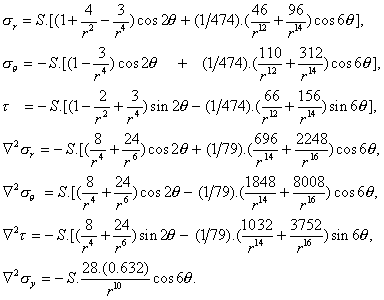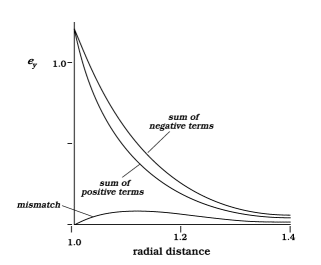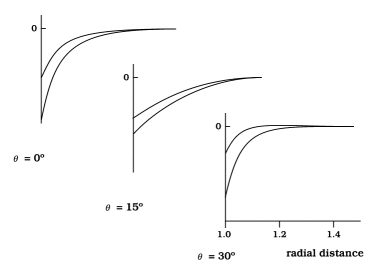An Approximate Solution
The solution explored is:
 |
Basis for the solution The terms multiplying cos 2q are the classical solution for a non-diffusing material. One can assume that diffusion effects will be stronger closer to the cylindrical interface and weaker far from it, so that higher powers of r will be needed in the added terms. Along with higher powers of r, higher powers or multiples of cos 2q seem appropriate, and cos 6q is the first multiple that satisfies the symmetry requirements in Figure 1. Using even powers of r is simply an algebraic convenience; choosing which powers to use is a matter partly of subjective judgment (see also the Discussion section below). Once powers of r have been selected, the numerical factors are fixed by four conditions as follows: (1) if the inclusion is non-diffusing, there can be no diffusive flux across the interface; if sr, sq and sy are taken to be independent agents each driving its own flux, we need three separate conditions at the interface:
 |
[10a,b,c] |
(2) Although in the matrix generally, plane strain is achieved only approximately, at the interface we can satisfy that condition exactly.
Corollaries of the solution Profiles of sr, sq and sy are shown in Figures 8 and 9. The expressions derived from j are:
 |
[11a-g] |
These satisfy the boundary conditions ey = eq = 0 at (r=1, q=0) if the materialís characteristic length L is 0.188 times the inclusionís radius, or L2 = 4NK = 0.0354. With these expressions, the linear strain rates follow from equations like equation [2].
To assess the quality of the approximate solution in view, one can look at the two conditions we wish to satisfy. First, we seek plane strain: ey should be zero not only at the interface but at all values of r and q; see Figure A3.1. Second, we have to maintain geometrical continuity in the material, in its velocity field; that is, the strain rates should satisfy equation [4]. On the left of this equation, g is linked to t through the materialís shear viscosity, whereas on the right the linear strain rates eq and er involve the stretching or shortening viscosity. In principle, whatever the stress fields, one can satisfy [4] by postulating just the needed material properties at every point, but for realism, we wish to rely on this artifice as little as possible. That is, if we make the trial for an isotropic material, we wish to find the left-hand side of equation [4] not very different from the right-hand side. Figure A3.2 shows the comparison for q = 0°, 15° and 30°; at 45°, both sides of the equation go to zero and higher values of q merely repeat the same sequence of comparisons. The agreement is not as close as one would wish; I imagine a more accurate solution would involve more powers of r and other multiples of q; but I also imagine that the extra algebraic complexity would not bring new principles to light; the present solution serves as regards bringing the needed principles into play.
 |
Figure A3.1 Deviation of ey from plane strain. |
 |
Figure A3.2 The two sides of equation [4] compared, assuming that the material in view is isotropic. |
[An obvious extension would be to admit diffusion and viscous creep in the inclusion as well as in the matrix, as in Finleyís study (1994), but this too would not involve new principles.]
Discussion Two aspects are touched upon, namely, the choice of powers of r in the trial solution [8] and [9] and a desirable refinement of equation-set [1].
As regards choice of powers of r, a point not yet made is that the one-dimensional solution is available as a guide: if the radius of the inclusion tends toward infinite while the characteristic length L remains fixed, conditions just outside the interface approach those at a planar interface, which are better known (Fletcher 1982; Bayly 1992 chapter 13). Specifically, at a planar interface, the rates of exponential diminution of stress away from the interface can be examined. As already remarked, when diffusion operates, we lose the simple relation sy = (sx+sz)/2 or (sr+sq)/2 and sy diminishes at its own rate with distance. In an appendix to chapter 13, it is shown that sy diminishes less rapidly outward than sz , and this fact led to smaller negative powers of r being used in equation [9] than in equation [8].
Secondly, in traditional uses of a Laplacian operator, the operand, for example temperature, is totally free of directional properties; but when the operand is directional, as in equation-set [1], the following seems desirable: in place of

one should write,
 |
[12] |
The distinction of J from K was not made earlier for the sake of simplicity, but logically it is a distinction that must be made.